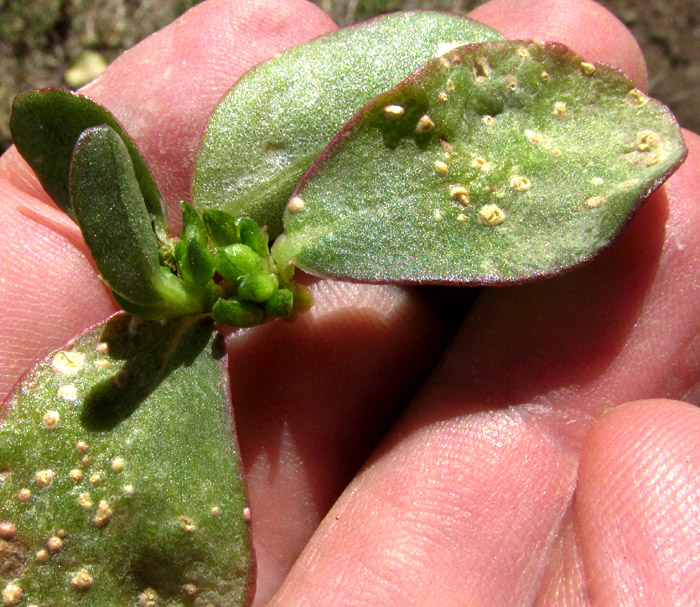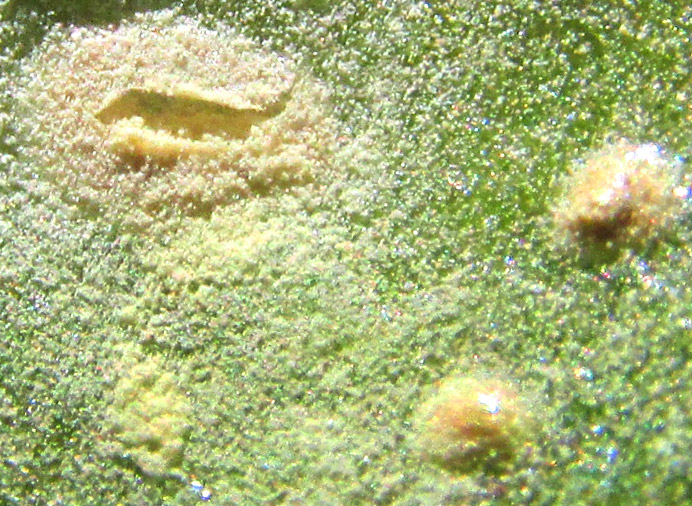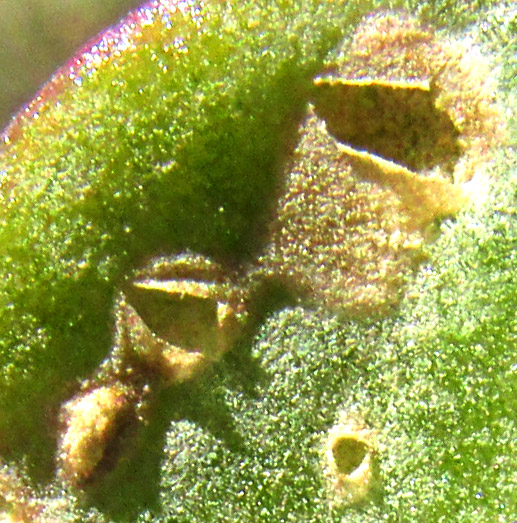Excerpts from Jim Conrad's
Naturalist Newsletter
Entry dated January 14, 2024, issued from near Tequisquiapan; elevation about 1,900m, (6200 ft), ~N20.57°, ~W99.89°; Querétaro state, MÉXICO
WHITE RUST

I eat a lot of wild Purslane, Portulaca oleracea, at least when it's available. At our upland, central Mexican location where it's seldom very hot or too cold, Purslane can be grown year-round if it's watered. However, we can have months of no rain at all, so it disappears during the dry months, except around favorite trees that get watered. I keep some pots of Purslane watered for occasional dry-season meals; above you see a sprig of Purslane from one of my pots. This entry is about the off-white spots and splotches covering my Purslanes' leaves.

With my hand lens, as seen above, the whitish spots proved to be immature and mature pustules, the covers of which burst open at maturity. Immediately this brought to mind the pustular Mint Rust fungus currently infesting another pot of Spearmint nearby in the same group of potted plants. Here's another shot, showing older pustules on the same plant:

In both of the above images, note the white, dusty-looking areas surrounding the blisters. The white areas are irregularly shaped, and most often concentrated near open blisters. I'm guessing that the tiny white specks are reproductive spores splashed from the blisters by my waterings, thus disseminating the spores to new areas for further infections.
It was easy to identify this disease organism; just do an Internet image search on the keywords "purslane white spots." Lots of pictures turn up showing what's seen above and, if the pictures are posted by someone with experience, usually they're identified as White Rust disease on Portulaca. Portulaca is the genus name for Purslane.
Identifying the disease organism was easy, but figuring out what kind of organism we had was harder. White Rust disease on Purslane is caused by the pathogen known as ALBUGO PORTULACAE, or else Wilsoniana portulacae, depending on your expert. Kew's GBIF page for the species currently lists Wilsoniana purtulacae as a synonym for Albugo portulae, but other authoritative sources say it's the other way around.
Whatever the most appropriate name, and despite the common name for the species, Albugo portulacae is not a rust, and not even a fungus. In fact -- as revealed by recent genetic studies -- it belongs to a whole phylum that most people never hear of. All animals with a spinal nerve cord, or notochord, like humans and mice, are in the phylum Chordata, all segmented animals with hard skeletons such as insects and crustaceans are in the phylum Arthropoda, and all flowering plants from oak trees to grasses and sedges belong to the phylum Magnoliophyta, so being in a phylum separate from all the commonly known ones is something very special.
Currently there appears to be uncertainty as to how to name the phylum to which our White Rust disease, Albugo portulacae, belongs. For example, at this writing, the Tree of Life Web Project, which aspires to show where every known living species occurs on the Phylogenetic Tree of Life, draws a blank on both the genus Albugo and Wilsoniana. Wikipedia's Albugo page assigns it to the phylum Oomycota but, on that same page, if you click for more information on the phylum Oomycota, you're directed to its Oomycete page where, it says, the Oomycota belong to the Phylum Gyrista. The classification of our organism seems to be in more of a state of rapid flux than usual.
Members of the phylum to which our organism belongs are different from fungi because of a complex of features not to be seen with the eye. For example, our organism's cell walls are composed of cellulose and beta glucans, while in fungi it's chitin, with cellulose only rarely present. Mitochondria in our organism are equipped with tubular cristae, while in fungi the cristae are flattened.
We just have to believe the experts when they insist that our White Rust organism isn't a rust and isn't a fungus, but rather something else, possibly most often commonly referred to as oomycetes, or, even more commonly, water molds -- even though they're not molds at all, and most species are terrestrial, not aquatic, pathogens.
Whatever our Purslane-afflicting organism is called and however it's classified, it's understood that our organism's spores germinate on leaves, the infected area becomes blistered, the pustule ruptures and one sees tiny, grainy sporangia, which raindrops can splash onto the host's surface, and infect more of the plant. Under certain conditions, oospores are produced, which can survive within dried leaf debris after the plants die.
I read that in greenhouses there's no controlling this disease organism other than by discarding all the plants and start over growing in soil free of the disease. Since I've not seen this disease on Purslane growing in hot weather, I suspect that when warmer weather comes, our wild Purslane plants' natural defenses will protect them from serious damage.
By the way, while the White Rust species may be limited in its occurrence, the oomycete category of living things really isn't as unusual as suggested by most people's unawareness of the existence of such a group. Ireland's Great Famine of 1845-1849, resulting from the failure of potato crops, was caused by an oomycete, as is the current outbreak of sudden oak death.
However, I find only one host mentioned for our Albugo portulacae, and that's members of the Purslane genus, Portulaca.